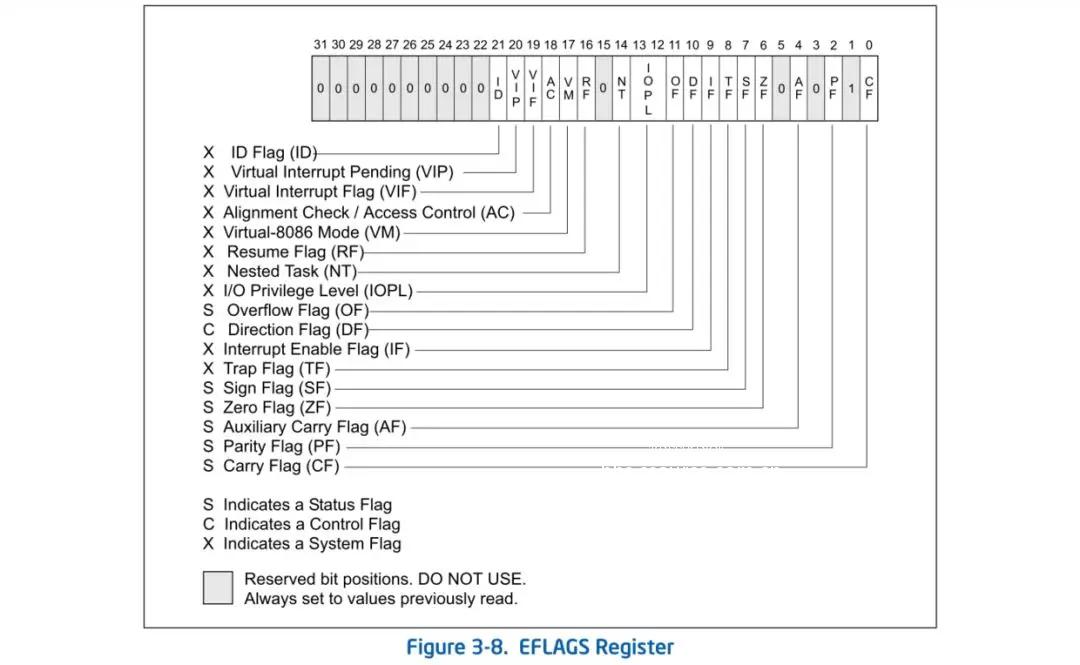夜月琉璃Lv46
编写驱动检测虚拟机
转自看雪论坛:https://bbs.pediy.com/thread-249594.htm
通过CPUID
原理:通过检查功能号1的CPUID返回的ecx的最高位是否为1,如果为1,则在虚拟环境下运行。真机的最高位不为1。
检测处理器是否支持 cpuid 指令(忽略这一条)
现在的CPU都支持 cpuid 指令,没必要去检测是否支持,除非在很早的的机器上运行才有必要(那好像也要80486的机器吧)。
在 eflags.ID 标志位是 Processor Feature Identification 位,即最高位,通过修改这个标志位的值,以此来检测是否支持 cpuid 指令。

要使用CPUID指令,输入eax表示功能号(类似中断的用法)
输出eax,ebx,ecx,edx
在EDX和ECX中返回的功能标志表明着该CPU都支持那些功能。
ECX返回值定义如下(资料来自Intel):
bit Name Description --------------------------------------------------------- 00 SSE3 Streaming SIMD Extensions 3 01 Reserved 02 DTES64 64-Bit Debug Store 03 MONITOR MONITOR/MWAIT 04 DS-CPL CPL Qualified Debug Store 05 VMX Virtual Machine Extensions 06 SMX Safer Mode Extensions 07 EST Enhanced Intel SpeedStep® Technology 08 TM2 Thermal Monitor 2 09 SSSE3 Supplemental Streaming SIMD Extensions 3 10 CNXT-ID L1 Context ID 12:11 Reserved 13 CX16 CMPXCHG16B 14 xTPR xTPR Update Control 15 PDCM Perfmon and Debug Capability 17:16 Reserved 18 DCA Direct Cache Access 19 SSE4.1 Streaming SIMD Extensions 4.1 20 SSE4.2 Streaming SIMD Extensions 4.2 21 x2APIC Extended xAPIC Support 22 MOVBE MOVBE Instruction 23 POPCNT POPCNT Instruction 25:24 Reserved 26 XSAVE XSAVE/XSTOR States 27 OSXSAVE 31:28 Reserved 下面是使用CPUID检测的核心汇编代码: .CODE getcpuid PROC xor eax,eax mov eax,1h cpuid mov a,eax mov b,ebx mov c_var,ecx mov d,edx ret getcpuid ENDP END
通过利用IoInitializeTimer配合IoStartTimer的定时器来循环判定。
遍历模块
我们说到的第一种CPUID的方法可能通过修改VMX的配置等方法绕过。
还有一种方式是遍历当前系统中所有的sys。我们要查找的是vmmouse.sys,vmrawdsk.sys,vmusbmouse.sys中的任意一个。
核心是利用NtQuerySystemInformation:
#include <ntddk.h>
#include <windef.h>
typedef struct _SYSTEM_MODULE_INFORMATION_ENTRY
{
HANDLE Section;
PVOID MappedBase;
PVOID Base;
ULONG Size;
ULONG Flags;
USHORT LoadOrderIndex;
USHORT InitOrderIndex;
USHORT LoadCount;
USHORT PathLength;
CHAR ImageName[256];
} SYSTEM_MODULE_INFORMATION, *PSYSTEM_MODULE_INFORMATION;
typedef NTSTATUS(*NTQUERYSYSTEMINFORMATION) (
IN ULONG SystemInformationClass,
OUT PVOID SystemInformation,
IN ULONG_PTR SystemInformationLength,
OUT PULONG_PTR ReturnLength OPTIONAL
);
VOID getcpuid();
BOOLEAN CheckDriverModule();
UNICODE_STRING symLinkName = { 0 };
PDEVICE_OBJECT pDevice;
PETHREAD pThreadObject = NULL;
BOOLEAN boom = FALSE;
//eax为CPU型号
//若为虚拟机,则ecx最高位为1;如果是物理机,则最高位为0.
//code in cpuid.asm
DWORD a = 0, b = 0, c_var = 0, d = 0;
VOID Unload() {//PDRIVER_OBJECT DriverObject
if (pThreadObject) {
boom = TRUE;
KeWaitForSingleObject(pThreadObject, Executive, KernelMode, FALSE, NULL);
}
if (pDevice) {
IoStopTimer(pDevice);
IoDeleteSymbolicLink(&symLinkName);
IoDeleteDevice(pDevice);
pDevice = NULL;
}
DbgPrint("Unload --------");
}
VOID TimerRoutine(PDEVICE_OBJECT DeviceObject, PVOID context) {
DbgPrint("In TimerRoutine\n");
//Begin normal check
getcpuid();
c_var = c_var >> 31;
if (c_var){
DbgPrint("Running in the virtual machine 2. Find VMWare by CPUID!!!!\n");
}
}
BOOLEAN CheckDriverModule() {
BOOLEAN bRet = FALSE;
NTQUERYSYSTEMINFORMATION m_NtQuerySystemInformation = NULL;
UNICODE_STRING NtQuerySystemInformation_Name = { 0 };
PSYSTEM_MODULE_INFORMATION ModuleEntry = NULL;
ULONG_PTR RetLength = 0, BaseAddr = 0, EndAddr = 0;
ULONG ModuleNums = 0, Index = 0;
NTSTATUS status = STATUS_SUCCESS;
PVOID Buffer = NULL;
RtlInitUnicodeString(&NtQuerySystemInformation_Name, L"NtQuerySystemInformation");
do
{
m_NtQuerySystemInformation = (NTQUERYSYSTEMINFORMATION)MmGetSystemRoutineAddress(&NtQuerySystemInformation_Name);
if (m_NtQuerySystemInformation == NULL) {
bRet = TRUE;
break;
}
status = m_NtQuerySystemInformation(0xb, NULL, 0, &RetLength);
if (status < 0 && status != STATUS_INFO_LENGTH_MISMATCH) {
bRet = TRUE;
break;
}
Buffer = ExAllocatePoolWithTag(PagedPool, RetLength, "ytz");
if (Buffer == NULL) {
bRet = TRUE;
break;
}
RtlZeroMemory(Buffer, RetLength);
status = m_NtQuerySystemInformation(0xb, Buffer, RetLength, &RetLength);
if (status < 0) {
bRet = TRUE;
break;
}
ModuleNums = *(ULONG*)Buffer;
ModuleEntry = (PSYSTEM_MODULE_INFORMATION)((ULONG_PTR)Buffer + 8);
for (Index = 0; Index < ModuleNums; Index++) {
if (strstr(ModuleEntry->ImageName, "vmmouse.sys") ||
strstr(ModuleEntry->ImageName, "vmrawdsk.sys") ||
strstr(ModuleEntry->ImageName, "vmusbmouse.sys")) {
DbgPrint("The Module Name is %s\n", ModuleEntry->ImageName);
bRet = TRUE;
break;
}
ModuleEntry++;
}
break; //Amuse
} while (TRUE);
if (Buffer)
{
ExFreePool(Buffer);
Buffer = NULL;
}
return bRet;
}
VOID CheckVmWare(PVOID context) {
LARGE_INTEGER sleeptime = { 0 };
sleeptime.QuadPart = -20000000;
while (1)
{
if (boom)
break;
if (CheckDriverModule()) {
DbgPrint("Running in the virtual machine 1. Find VMWare!!!!\n");
}
DbgPrint("Thread is working");
KeDelayExecutionThread(KernelMode, 0, &sleeptime);
}
PsTerminateSystemThread(STATUS_SUCCESS);
}
NTSTATUS DriverEntry(PDRIVER_OBJECT driverObject, PUNICODE_STRING RegPath) {
HANDLE hThread = NULL;
NTSTATUS status = NULL;
UNICODE_STRING DeviceName = { 0 };
driverObject->DriverUnload = Unload;
status = PsCreateSystemThread(&hThread, 0, NULL, NULL, NULL, CheckVmWare, NULL);
if (!NT_SUCCESS(status)) {
DbgPrint("Create Thread Failed!\n");
return STATUS_UNSUCCESSFUL;
}
status = ObReferenceObjectByHandle(hThread, THREAD_ALL_ACCESS, *PsThreadType, KernelMode, &pThreadObject, NULL);
if (!NT_SUCCESS(status))
{
DbgPrint("Cannot reference");
ObDereferenceObject(pThreadObject);
}
RtlInitUnicodeString(&DeviceName, L"\\Device\\MyDevices");
status = IoCreateDevice(driverObject, 0, &DeviceName, FILE_DEVICE_UNKNOWN, 0, TRUE, &pDevice);
if (!NT_SUCCESS(status)) {
DbgPrint("Create Device Failed!");
return STATUS_UNSUCCESSFUL;
}
RtlInitUnicodeString(&symLinkName, "\\?\\SybLinkName");
status = IoCreateSymbolicLink(&symLinkName, &DeviceName);
if (!NT_SUCCESS(status)) {
DbgPrint("Create SymLink Failed!");
//return STATUS_UNSUCCESSFUL;
}
IoInitializeTimer(pDevice, (PIO_TIMER_ROUTINE)TimerRoutine, NULL);
IoStartTimer(pDevice);
ZwClose(hThread);
return STATUS_SUCCESS;
}注:在X64下使用上文的汇编代码时,需要修改下asm的属性。

效果:

github:
https://github.com/pcy190/DriverKit/tree/master/AntiVirtualMachine_driver
2 已被阅读了7175次 楼主 2019-03-03 20:38:32



